Hedges provide a feeling of enclosure, security and shelter, but also have more subtle benefits of reducing air pollution and noise. A study in 2018 by Surrey University showed that hedges of head height, planted along busy roads, filtered out 30-50% of the air pollution from traffic. The ability of trees to filter out microscopic air-born particles has been demonstrated to be particularly efficient in small silver birch, yew and elder trees.
Garden hedges for wildlife
Foxburrow Farm hedge by Cathy Smith
Hedges, both urban and rural, can provide a plentiful larder for wildlife. The UK Biodiversity Group have shown that across Britain 600 species of flowering plant, 1500 insects, 65 birds, and 20 mammals have been recorded in hedges.
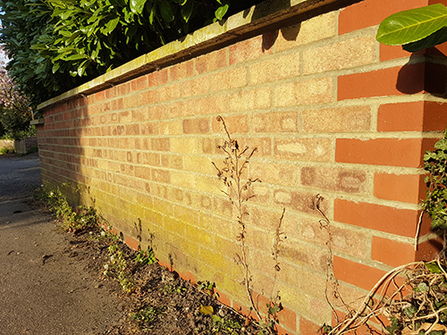
Brick wall by Cathy Smith
Let’s start with a brick wall. It offers shelter, which with underplanting of drought-tolerant plants and in at least partial sun, could provide a welcome nook for butterflies. Clever designs of plant troughs can be overflowing with nectar rich plants, such as flowering herbs, tempting bees into our gardens. Maybe a nest box or a climber such as honeysuckle could add a few more notches to the wildlife score? On the whole though, the brick wall in itself has limited potential as a wildlife habitat and one glaring negative, of being a barrier to animal movement such as hedgehogs unless a hole is left at the base.
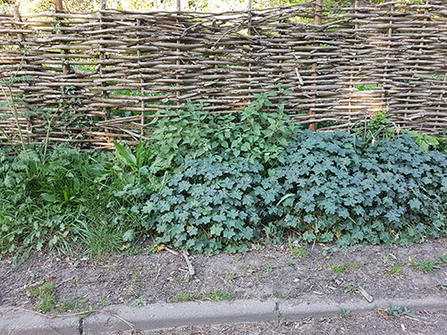
Woven hazel fence by Cathy Smith
A wooden fence, then?
A more permeable feature, allowing small animals free movement whilst restricting pets from escaping. As with brick wall, there is the possibility of enhancing its value to wildlife by adding ‘green’ features. There are some good examples where the ground beneath hosts long grasses and wildflowers, perhaps a little refuge from the mower blade. Other gardeners keen to maximise planting space plant lavenders or antirrhinums at the base of the fence. A fence needs less footings so the earth along its base gives a little more opportunity for nature to creep in than a wall. Fences come with their own caution of treated timbers, and the dangers of concrete gravel boards which creating an impenetrable boundary to animals such as hedgehogs. Thankfully, help is on hand with companies now manufacturing gravel boards with hedgehog sized ‘doors’ in. Better still, have a fence, but let the panels float above the ground, and let the flowers move in.
Green boundaries must surely offer more than brick or wood?
It could be argued that any hedge is better than none, but not all hedges are equal in their value to wildlife.
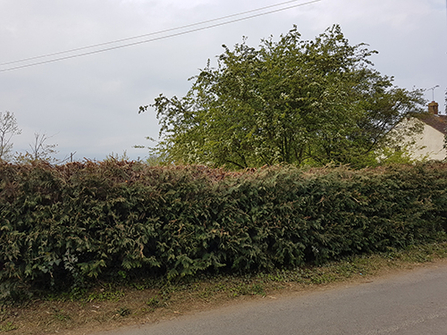
Lleylandii hedge by Cathy Smith
Leylandii hedges have their own legislation due to their unsuitability for a garden hedge, towering ever skywards and blocking out valuable light to neighbouring gardens. Leylandii also hates being trimmed back to more than the current years growth, cut back further and you are left with an unappealing wall of dry brown sticks. It is a hungry feeder too, the base of a leylandii hedge leaves little nutrients for flowers to flourish. On a positive note, the evergreen cover can provide nest sites for early nesting birds and a bit of winter shelter, I am sure we can do better though!
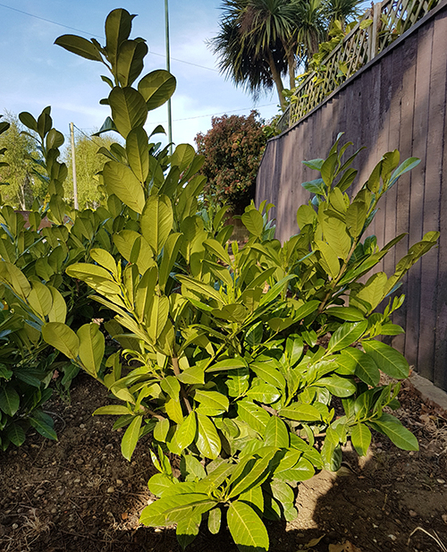
Laurel hedge by Cathy Smith
Cherry laurel seems to be taking the place of leylandii as the go-to evergreen hedging material. It shares some of the reservations that come with leylandii. It is large leaved and vigorous bushy shrub, making an uninteresting hedge. The leaves smell of almonds when crushed due to the hydrogen cyanide they contain which also makes it unpalatable to invertebrates. If allowed to flower the nectar can attract insects such as ants and hoverflies and the berries provide food for birds. Unfortunately, though, allowing it to flower runs the risk of letting it run rampant in the countryside where in places it has become an invasive weed.
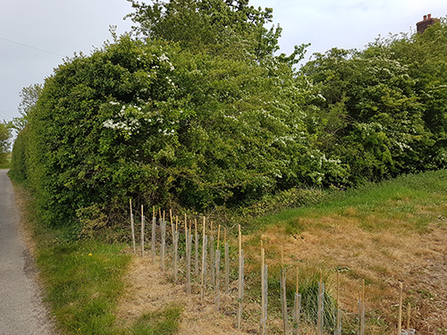
Well grown hedge corner by Cathy Smith
So what alternatives are available which favour wildlife, have the makings of a good garden boundary and grow in a reasonable time frame? What better than a hedge planted with native species, widely available, affordable and quick growing. Hedges provide the shelter we are looking for but being semi-permeable but don’t result in damaging eddies of wind. They allow wildlife, such as hedgehogs, to move between gardens for feeding and breeding purposes. Native hedges offer a plentiful larder for nature in the form of leaves, nectar-rich flowers, berries, fruits, seeds and nuts. Hedges also provide nesting sites for some of our favourite garden birds - dunnocks, aptly named the hedge sparrow.
If you are lucky enough to be already have one of these wildlife rich hedges, how can you maximise its value to nature?
Spring is the time to enjoy our hedges bursting into flower, willow catkins, blackthorn flowers, followed by hawthorn, crab apple and cherry blossom are top choices for our pollinating insects such as bees and hoverflies. You could choose to let one of these species grow into a standing tree along the hedge line, an attractive feature and for greater feeding opportunities.
The main bird nesting season is between 1st March – end of July. All wild breeding wild birds and their nests are protected by law. Any hedge maintenance must be kept to the very minimum such as hand trimming and hedges checked for nests first.
But before we all rush for the hedge trimmer at the end of the summer, let’s think about the harvest for the birds. Hawthorns, blackthorn, crab apple, rose hips and blackberries that we enjoy too are about to put on their show. Wait until November or as late as February and watch blackbirds, thrushes and robins take their share. For the best fruiting hedge, trim on a three-year rotation, cutting only once every three years results in 2.5 times more hawthorn and blackthorn flowers than cutting every year.
Once established, restrain the urge to tidy the base of the hedge. Here is where wildflowers such as primroses and knapweed might establish, or where frogs and hedgehogs might seek refuge.
The best time to plant a hedge of native plants is between November-March so time to get planning and get your 'native hedgerow mix' order in.
